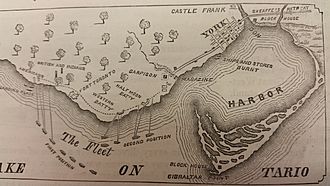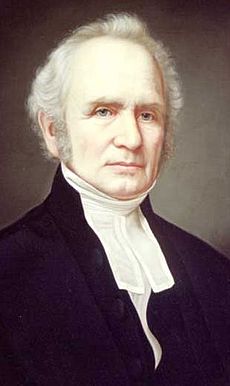Battle of York facts for kids
Quick facts for kids Battle of York |
|||||||
|---|---|---|---|---|---|---|---|
| Part of the War of 1812 | |||||||
 Battle of York by Owen Staples, 1914. The American fleet before the capture of York. |
|||||||
|
|||||||
| Belligerents | |||||||
Ojibway |
|||||||
| Commanders and leaders | |||||||
| Strength | |||||||
| 300 regulars 300 militia 40–50 Natives |
1,700 regulars 14 armed vessels |
||||||
| Casualties and losses | |||||||
| 82 killed 112 wounded (including 69 wounded prisoners) 274 captured 7 missing |
55 killed 265 wounded |
||||||
The Battle of York was an important fight during the War of 1812. It happened in York, Upper Canada on April 27, 1813. Today, York is known as Toronto, Ontario, Canada.
An American army, helped by many ships, landed near the town. They marched against York, which was defended by a smaller force. This force included British soldiers, local volunteers (called militia), and Ojibwe Native warriors. Major General Roger Hale Sheaffe, who was in charge of Upper Canada, led the defenders.
Sheaffe's forces were defeated. He retreated with his remaining soldiers, leaving the militia and townspeople behind. The Americans took control of the fort, the town, and the shipyards. However, they lost many soldiers, including their leader, Brigadier General Zebulon Pike. He was killed when the British blew up the fort's gunpowder storage as they left. After the battle, American soldiers caused damage and took things from the town before leaving a few days later.
Even though the Americans won, this battle did not change the overall plan of the war much. York was not as important as Kingston, where the main British warships on Lake Ontario were kept.
Contents
Why the Battle Happened: Background
York was the capital of Upper Canada. It was located on the north shore of Lake Ontario. During the War of 1812, Lake Ontario was a key battleground. It was also the main way for the British to get supplies from Quebec to their forces further west.
At the start of the war, the British had a small navy called the Provincial Marine. They controlled Lake Ontario and Lake Erie. This helped Major General Isaac Brock win several battles in 1812. He could quickly move his small army to different places to stop American attacks.
The United States Navy wanted to take control of the lakes. They sent Commodore Isaac Chauncey to build a strong fleet of ships at Sackett's Harbor, New York. To keep up, the British started building new warships. One was the Wolfe in Kingston, and another was the Sir Isaac Brock at the York Naval Shipyards.
Planning the Attack: Prelude
American Plans for York
In January 1813, John Armstrong Jr. became the United States Secretary of War. He understood the situation on Lake Ontario. He planned for 7,000 soldiers to gather at Sackett's Harbor by April 1. With Chauncey's ships, they would attack Kingston. Kingston was important because it was where the British navy was based. Capturing it would weaken British control in Upper Canada. After Kingston, they planned to attack York and Fort George.

However, American commanders, Major General Henry Dearborn and Commodore Chauncey, changed their minds. They thought Kingston was too strong to attack. They believed the British had many soldiers there, even though this was not true. Also, Dearborn's army was smaller than planned due to sickness.
So, in March, Chauncey and Dearborn suggested attacking York instead. York was the capital, but it was not as important militarily as Kingston. Secretary Armstrong agreed to this change. He thought an easy win at York would be good for American morale and politics.
The attack was supposed to happen in early April. But bad weather delayed it for several weeks. The American ships finally left Sackett's Harbor on April 24, 1813.
British Preparations for Defense
York was not well protected. There were not enough resources to build strong defenses. So, Sheaffe told government workers to hide important papers in the woods. This was to keep them safe if an attack happened.

York's defenses included blockhouses near the Don River and at Fort York. There was also a blockhouse at Gibraltar Point. The town also had three gun batteries at the fort and another nearby with two large cannons. A rough battery, called the Western Battery, was about 1.6 kilometers (1 mile) west of the fort. It had two old cannons that could still fire.
Fort York also had a western wall and a small dirt wall. About a dozen cannons were placed in these spots. Sheaffe was in York for official duties. He had planned to leave, but he suspected an American attack.
His soldiers included companies from the 8th Regiment of Foot, the Glengarry Light Infantry, and the Royal Newfoundland Fencibles. There were also a few soldiers from the 49th Regiment of Foot and the Royal Artillery. About 40 to 50 Mississaugas and Ojibwe warriors also helped defend York, along with the local Canadian militia.
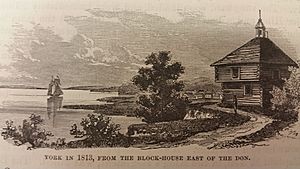
British lookouts spotted the American ships on April 26. They used flags and signal guns to warn the town. The militia was called to gather, but only about 300 men showed up quickly. Sheaffe thought the Americans would attack from two directions. He placed most of his soldiers, Native warriors, and some militia at Fort York. Most of the militia and some soldiers from the 8th Regiment were at the town's blockhouse.
The Battle Unfolds
The American ships arrived off York late on April 26. Chauncey's fleet had a large warship, a smaller brig, and twelve schooners. The American army, led by Brigadier General Zebulon Pike, had between 1,600 and 1,800 soldiers. General Dearborn, the overall army commander, stayed on his ship, the Madison.
On the morning of April 27, the first American boats landed about 6.4 kilometers (4 miles) west of the town. About 300 American soldiers landed, supported by fire from Chauncey's ships. Strong winds pushed their boats further west than planned, into a wooded area.
Only Native warriors, led by James Givins, and a company of the 8th Regiment of Foot, first fought the Americans. British units from Fort York had to go through the forest to reach the landing site. Sheaffe also sent Glengarry Light Infantry soldiers to help, but they got lost.
As more Americans landed, the British and Native forces were surrounded and slowly fell back into the woods. The U.S. 15th Infantry Regiment landed next, followed by General Pike, who took charge. Sheaffe arrived with more soldiers and militia. The British soldiers charged the Americans but were pushed back. Pike ordered his troops to advance, pushing Sheaffe's forces back. The British began to retreat.
While the landings happened, American ships fired on the four gun batteries defending York. British cannons fired back but were not very effective.
The British tried to regroup at the Western Battery. But the battery's gunpowder storage exploded by accident. This caused more losses and confusion for the British soldiers. They fell back to a ravine north of the fort, where the militia was gathering. American forces moved east towards the fort, firing cannons at it.
Sheaffe decided the battle was lost. He ordered his soldiers to retreat. He also ordered the wooden bridge over the Don River to be burned to stop the Americans from following. He told the militia to surrender. But without telling the militia officers, he also ordered a ship under construction, HMS Sir Isaac Brock, to be burned. He also ordered the fort's gunpowder magazine to be blown up.
Around 1:00 pm, the Americans were close to the fort. General Pike was asking a prisoner about the fort's defenders. Soon after, the fort's magazine, which held a huge amount of gunpowder, exploded. This explosion sent debris flying over 450 meters (500 yards). General Pike and 37 other American soldiers were killed. Another 222 were injured. Fearing a counterattack, the Americans regrouped. They did not enter the abandoned fort until the British soldiers had left.
Counting the Losses
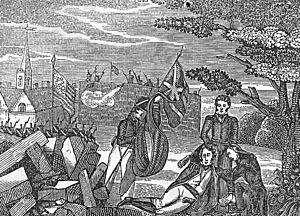
The Americans officially reported 55 killed and 265 wounded. Most of these casualties happened because of the fort's exploding gunpowder magazine. Later studies suggest the Americans were just in the wrong place at the wrong time.
The British officially reported 153 casualties. But this number did not include militia, sailors, or Native Americans. Historians now believe the actual British losses were much higher: 82 killed, 43 wounded, 69 wounded prisoners, 274 captured, and 7 missing. This makes a total of 475 casualties.
Surrender and Aftermath
Colonel William Chewett and Major William Allen of the York militia tried to arrange a surrender. Captain John Beverley Robinson, a lawyer, helped them. It took time because the Americans were angry about their losses. They believed the British had destroyed the fort and ship after surrender talks had started.
The next morning, General Dearborn finally agreed to the surrender terms. These terms allowed government workers to continue their jobs and doctors to treat the wounded. Any soldiers remaining in York became prisoners of war. Militia members were allowed to go home, but they could not fight again until they were officially released.
The Americans took control of the shipyard. They captured a ship called Duke of Gloucester and many cannons. Another British ship, Prince Regent, had sailed to Kingston two days before the attack, so the Americans missed it. The Americans also demanded and received a large amount of money from the Receiver General of Upper Canada.
The Burning of York
From April 28 to 30, American troops took many items from the town. Some soldiers set fire to the buildings of the Legislative Assembly and the Government House, where the Lieutenant Governor lived. It was said that American troops found a scalp there, but local stories say it was actually the Speaker's wig. The Parliamentary mace of Upper Canada, a symbol of authority, was taken to Washington. It was returned to Canada only in 1934 as a gift from President Franklin D. Roosevelt. The printing office, where official documents and newspapers were made, was also damaged.
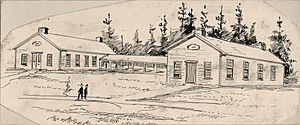
Other Americans stole from empty houses, claiming the owners were militia members who had not surrendered properly. Homes of Canadians connected with Native people were also looted. Before leaving York, the Americans burned most of the buildings at the fort, except for the barracks.
Commodore Chauncey's officers took books from York's first library. When Chauncey found out, he had the books returned during a later visit in July. However, the library had closed by then, and the books were sold off years later.
General Pike had ordered his soldiers to respect civilian property. He said any soldier caught stealing would be punished. Dearborn also said he did not order any buildings to be destroyed. But he could not control his soldiers. Dearborn was embarrassed by the looting. He wanted to leave York as soon as possible.
After the Battle: What Happened Next?
The Americans stayed in York for almost two weeks. They sent captured military supplies away on May 2. But then a storm kept their ships in York harbour. The ships were so crowded with soldiers that only half could go below deck to escape the rain. They finally left York on May 8 and sailed to the Niagara peninsula. Sheaffe's soldiers had a difficult two-week march overland to Kingston.
About 300 to 400 Iroquois warriors marched towards York to attack the Americans. But they learned the Americans had left York and called off their plan.
How the Battle Changed the War
Many people in Upper Canada criticized Sheaffe for his actions during the battle. They felt he did not lead his troops well. As a result, Sheaffe lost his military and public jobs in Upper Canada.
However, the Americans did not completely destroy the British navy on Lake Ontario. By saving his soldiers instead of fighting a hopeless battle, Sheaffe prevented a total defeat. The American Secretary of War noted that British commanders would likely try to save their troops rather than lose them in a fight.
The Battle of York had a big impact on Lake Erie. The captured cannons and supplies meant for the British navy there contributed to their defeat at the Battle of Lake Erie. However, most of the naval supplies captured at York were not used by the Americans. Some were left behind, and others were burned during the Second Battle of Sacket's Harbor in May 1813.
Impact on Society
The American attack on York happened during New York's election period. While the battle itself did not directly help the Democratic-Republican Party, early victory announcements before the battle did help their candidate, Daniel D. Tompkins, win the election for Governor of New York.
The battle and the American occupation of York were a major event for the people living there. Those who fought the Americans were seen as heroes. Those who helped the Americans were seen as traitors. Some historians believe the battle helped create a stronger Canadian identity. The harsh treatment of Canadian civilians by American forces, and the burning of British buildings, made Canadians feel more united against the United States.
Many people saw the American actions at York as a reason for the British to burn Washington later in the war. British Governor General Prévost said it was "just retribution."
Later Attacks on York
Second American Visit in July 1813
After the Battle of York, Chauncey and Dearborn won the Battle of Fort George. But they left Sackett's Harbor weakly defended. When British ships arrived in Kingston, they attacked Sackett's Harbor. The British were pushed back, but Chauncey stayed in Sackett's Harbor until a new warship was ready.
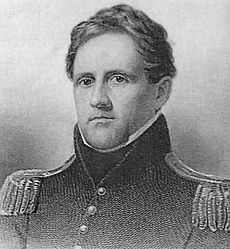
Chauncey sailed out again on July 21 with 13 ships. Six days later, he picked up 500 soldiers led by Colonel Winfield Scott. They planned to attack British supply lines at Burlington Heights. But the British defenses were too strong.
Because most of York's militia were still on parole (released but not allowed to fight), the town was largely undefended. The American ships went to York to get food for their soldiers. The few remaining British soldiers in York took what supplies they could and left. The Americans landed 340 men without a fight. They burned the barracks at the fort, the military fuel yards, and took things from several properties. They also seized 11 small boats, 5 cannons, and some flour. They left later that night. The library books that were taken in April were returned during this second visit.
A plaque was put up in 1968 to remember this event. It explains how American soldiers landed, took supplies, and burned military buildings.
Third American Visit in August 1814
After the second American visit, York's defenses were greatly improved. The British needed to protect four ships stationed in the harbour. On August 6, 1814, American ships chased a British ship, HMS Magnet. Its captain set it on fire to prevent capture. The Americans suspected the ship came from York, so they went there to check the defenses.
Near York's harbour, an American ship approached under a white flag to try and see the town's defenses. But the militia at Fort York fired at the ship, which fired back before leaving. The 8th Regiment of Foot and the 82nd Regiment of Foot were sent to York to strengthen its defenses. The American ships did not attack the new defenses. They stayed outside York's harbour for three days before sailing away.
Remembering the Battle: Legacy
The burning and looting of York, along with other Canadian towns, changed how people in Upper Canada felt about Americans. Before the war, many American settlers had moved to Upper Canada. But after the war, a strong dislike for the United States grew among the settlers. Historians say that the burning of York and other American actions helped create a "national story" for Canada. This story sees the War of 1812 as the "birth of the Canadian nation."
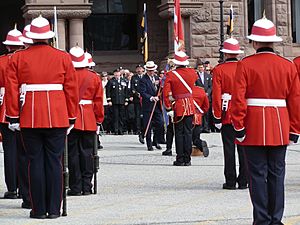
Several Canadian Army Reserve units today carry on the history of the militia and soldier units that fought in the Battle of York. These include the Stormont, Dundas and Glengarry Highlanders, the Queen's York Rangers, and the Royal Newfoundland Regiment. In the United States Army, five active battalions carry on the history of American units that fought at York. In the British Army, the 8th Regiment of Foot is now part of the Duke of Lancaster's Regiment.
On July 1, 1902, Walter Seymour Allward created the Defence of York monument at the Fort York burial grounds. This monument honors those who defended York, and all British, Canadian, and Native warriors who fought in the War of 1812.
On April 27, 2013, the City of Toronto government and the Canadian Armed Forces celebrated the 200th anniversary of the battle. A ceremony took place at Queen's Park, led by Prince Philip. A military parade of 1,500 sailors and soldiers marched from Queen's Park to Fort York. These events were part of wider celebrations for the 200th anniversary of the War of 1812. During these celebrations, the City of Toronto Museum Services created an exhibit called Finding the Fallen: the Battle of York Remembered at Fort York. This exhibit tries to find and remember all the American, British (including militia), and First Nations fighters who died in the battle.


